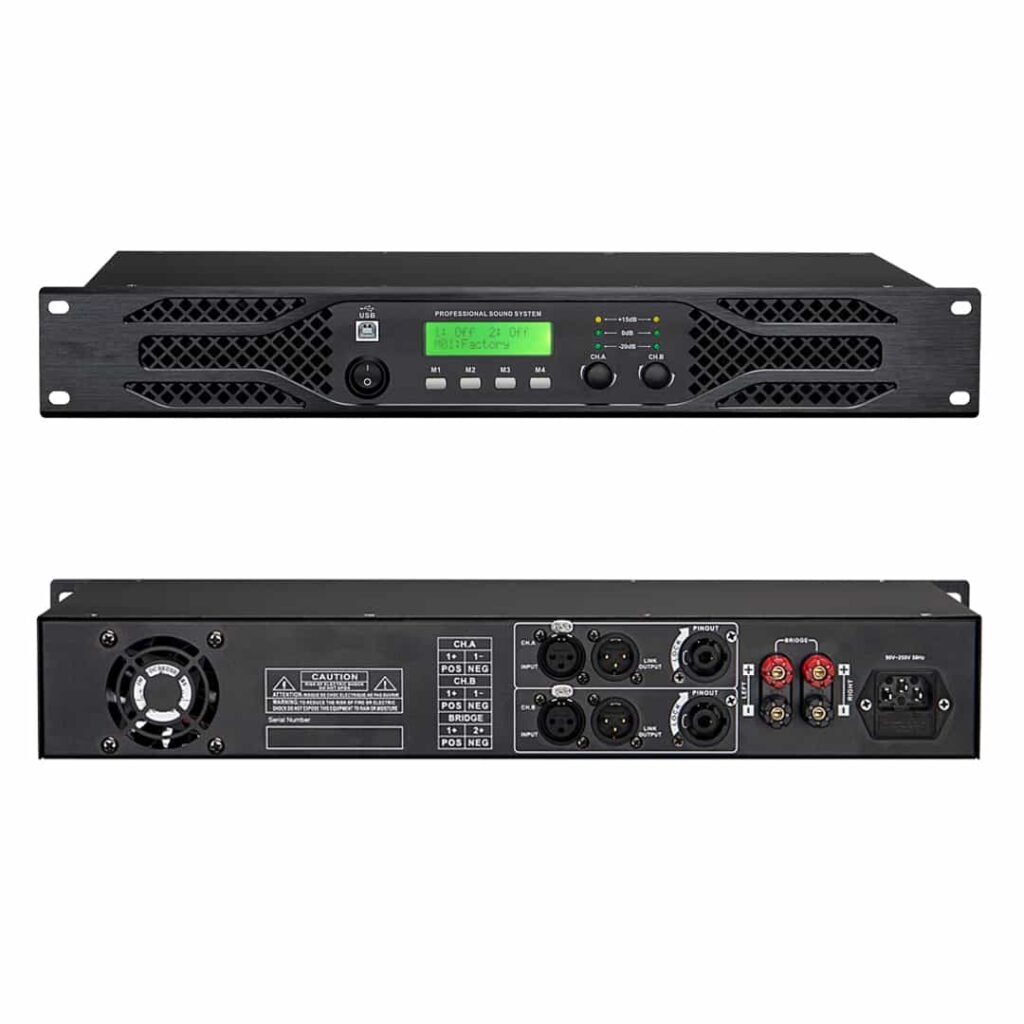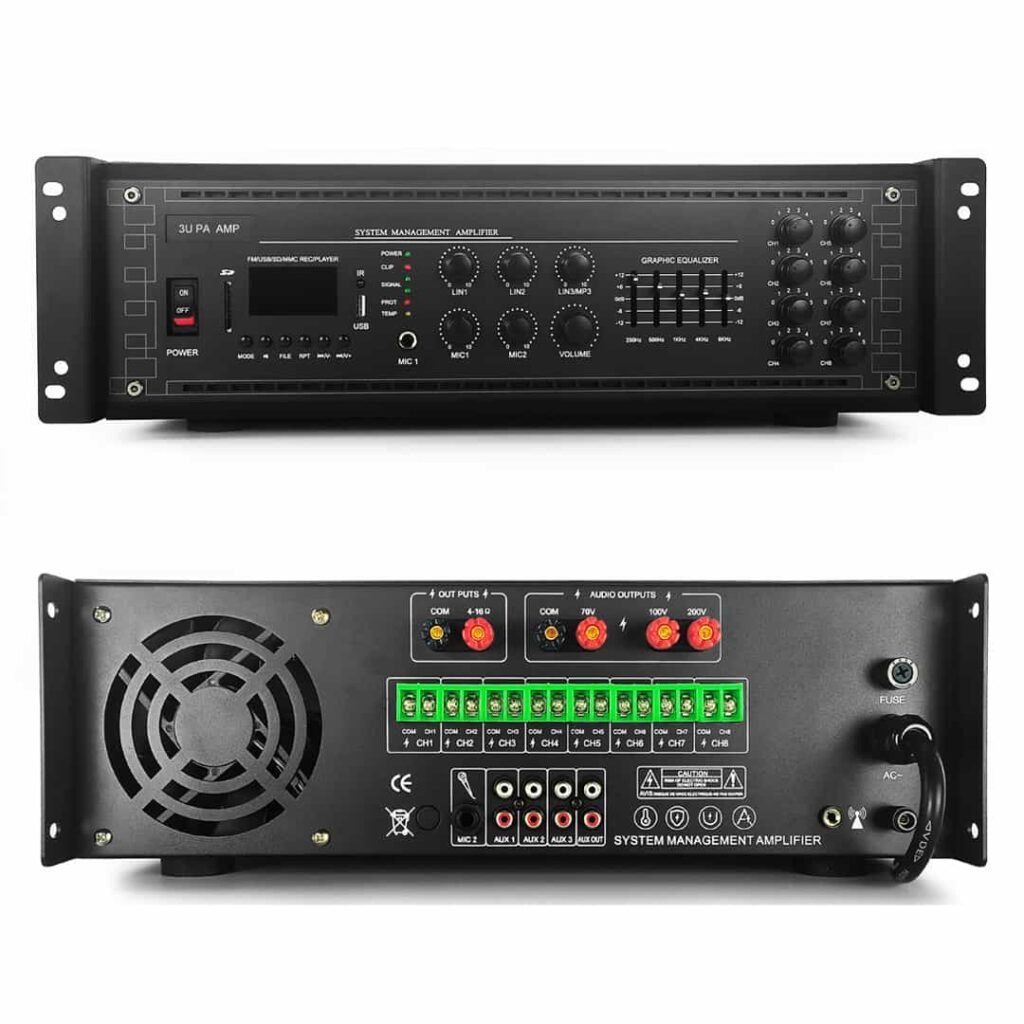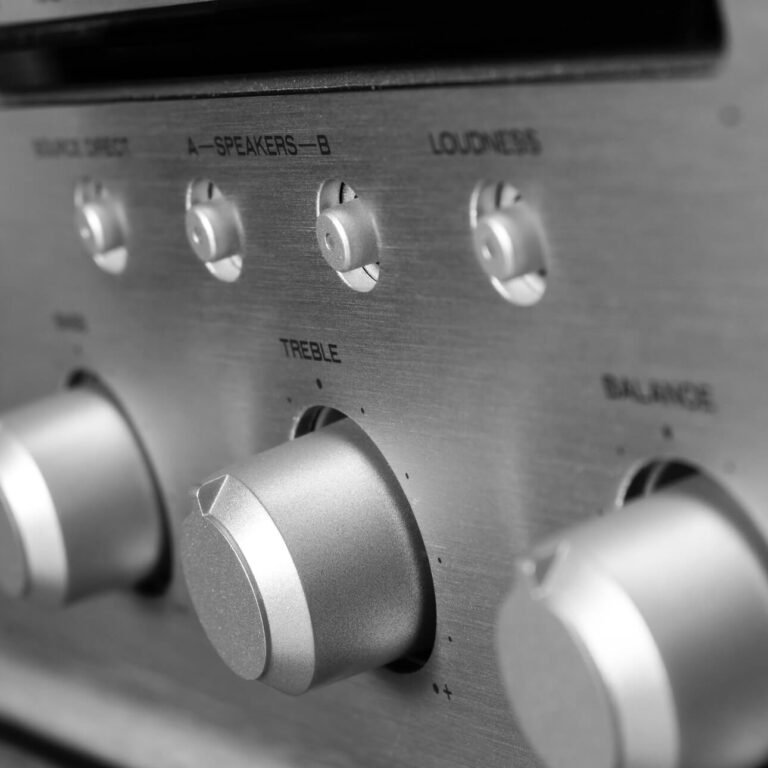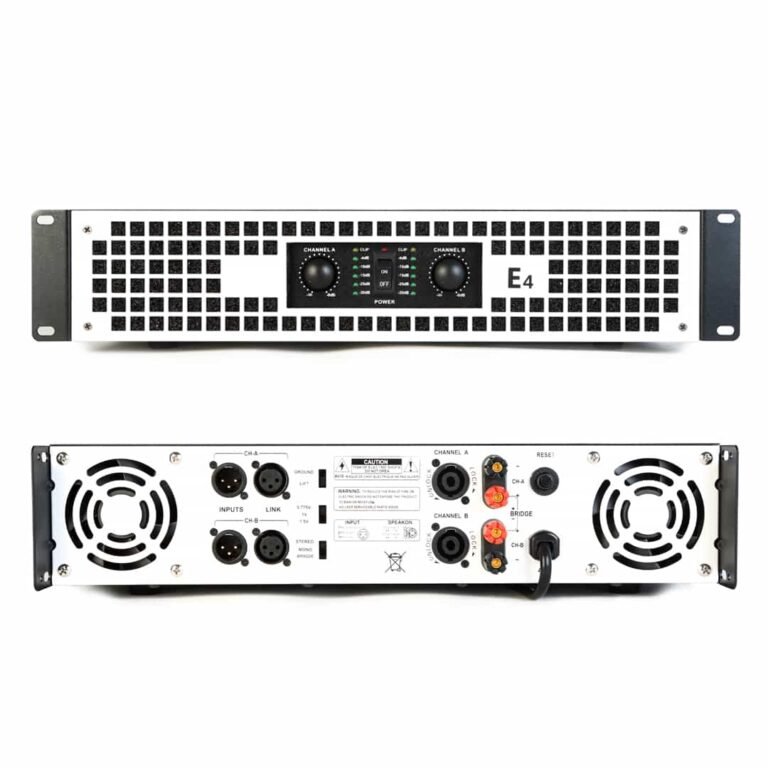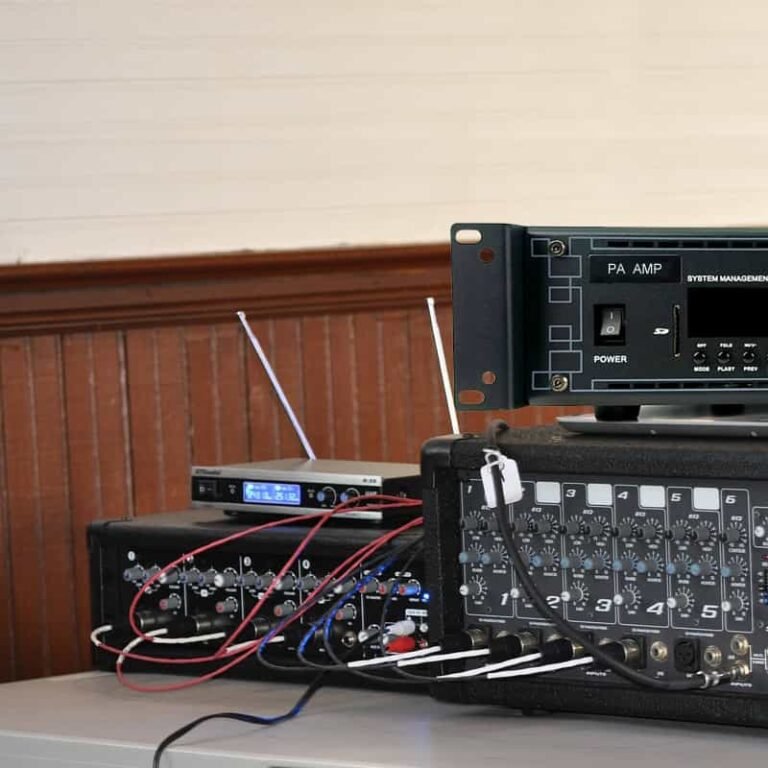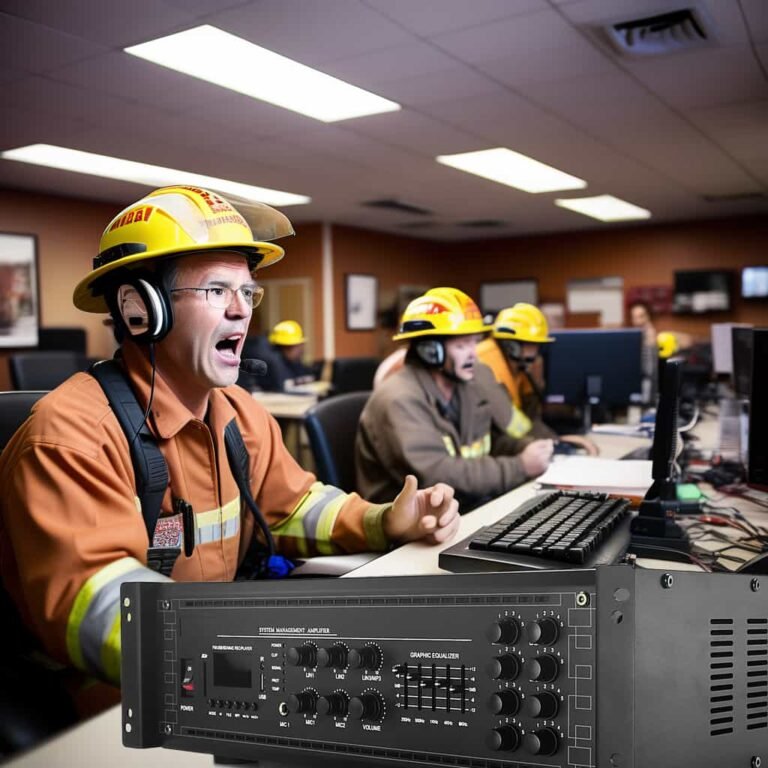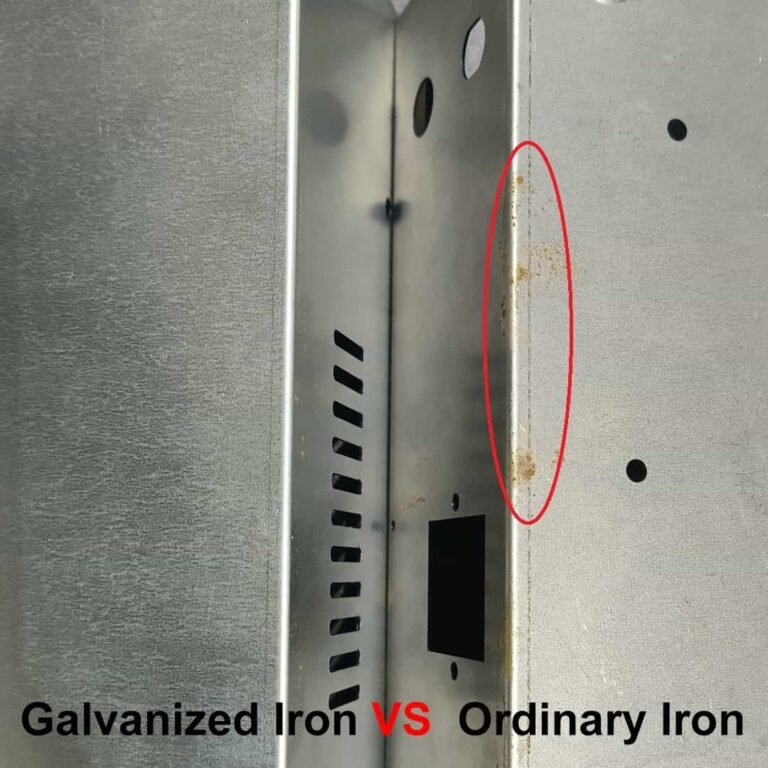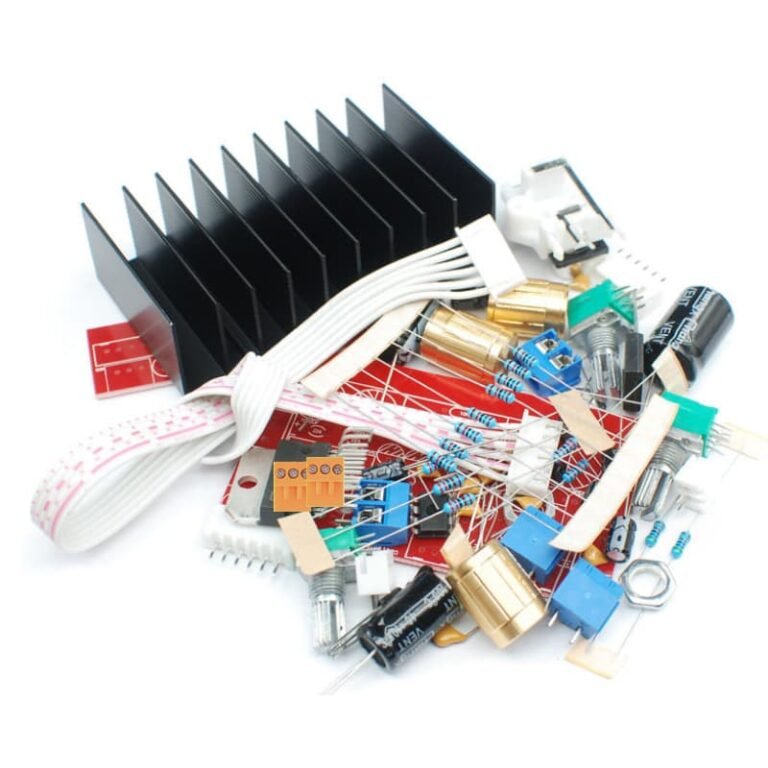A PA system or public address system is an audio amplification system used to increase volume and distribute sounds to an audience. PA systems are an essential part of firefighting, stations, sporting events, conferences, schools, and other settings where voice reinforcement or playback of pre-recorded material is required.
The PA system consists of five core components, they are the mixing console, public address amplifiers, loudspeakers, microphones, and transmission cables. Firstly, the mixing console is responsible for receiving audio signals from microphones and playback devices, mixing, processing, and routing these signals finely. Then, the main function of the power amplifier is to boost these low-level audio signals so that they have enough power to drive the loudspeakers, thus ensuring the audience can hear the sound clearly. The loudspeaker’s role is to produce sound by converting the electrical signals it receives into sound waves. The microphone, on the other hand, is responsible for converting the sound waves into electrical signals and amplifying them for subsequent processing. The transmission cables serve as a link between all the components and ensure that the entire PA system works together.
The PA system ensures that performers, presenters, and announcers are clearly heard by all attendees. With even coverage, sound reinforcement systems provide an enhanced audio experience for audiences and meet the audio needs of different occasions. Whether it’s a small gathering in a conference room or a huge crowd at a concert, the PA system delivers audio information accurately, ensuring smooth communication and sharing. Its efficient performance and adaptability make it an indispensable audio solution for all occasions.
Power Requirements
The power requirements of a PA system depend on two main factors: the number of spectators to be covered and the size of the venue. The larger the audience, or the farther away the sound reinforcement needs to be heard, then a higher power sound reinforcement system is required to ensure the clarity and legibility of the sound. Similarly, if the venue space is large, the need for sound is evenly dispersed throughout the space, but also a higher power PA system to achieve this goal.
Some key factors that determine how much power a PA system requires:
- Audience size – The number of people that need to clearly hear the amplified sound. More people means more power is needed.
- Room size – The dimensions, layout, and acoustics of the venue space. Larger and more open spaces require greater power.
- Speakers – The number, type, and size of speakers. More and larger speakers equals more power needed to drive them.
- Volume – The necessary loudness level for the audience size and venue. Higher volumes require greater amplifier power.
- Headroom – Having an amplifier power overhead prevents distortion at loud volumes. 30-50% extra power is recommended.
The wattage required can vary greatly based on these factors – a small 50-person venue may only require 250-500 watts, while a large stadium concert could require over 20,000 watts. Most venues will have some guidelines for the electrical power available on their technical specification sheet to help determine what PA power is realistic.
Speaker Power Ratings
Loudspeaker power handling is usually expressed in watts RMS (root mean square), which indicates the continuous power a loudspeaker can handle without damage.
To determine the current draw (amperage) of a loudspeaker, apply Ohm’s Law to convert the power rating to amperage. The formula is Amps = Watts/Volts.
For example, if the speaker is rated at 600 watts RMS and is connected to a 120-volt AC circuit, the current draw will be 5 amps.
Also important is the impedance of the speaker. an 8-ohm 600-watt RMS speaker draws more current than a 16-ohm speaker of the same power because impedance affects the voltage drop.
Note that speaker power ratings are sometimes peak watts rather than RMS. Peak is higher than RMS and this should be taken into account when calculating current. To convert peak watts to rms divide by 2.
The full-range response of a speaker also affects its power handling capability, with lower frequencies requiring more power. Full-range PA speakers have a greater current capacity than high-frequency tweeters.
In summary, check information such as the speaker’s RMS power rating and impedance to determine the minimum amplifier current (amperage) required. This ensures that the amplifier will provide enough pure power to properly drive the speaker.
Amplifier Power
The power of a PA system comes primarily from amplifiers, which receive low-power signals from the mixer and boost the power significantly to drive the speakers.
Amplifier power is measured in watts, with ratings ranging from a few hundred watts for small systems to tens of thousands of watts for large concert sound reinforcement systems. To determine the amount of amplifier power required, you first need to consider the power handling capability of the speakers. For example, if each loudspeaker has a continuous power rating of 200 watts and there are 2 loudspeakers, an audio amplifier of at least 400 watts is required.
In addition, it is important to avoid underpowered speakers to prevent distortion at high volumes. It is recommended that the power of the amplifier be greater than the power rating of the speakers.
When choosing a PA amplifier, pay attention to key parameters such as continuous power rating, peak power rating, and output impedance (e.g., 4 ohms or 8 ohms). Ensure that the impedance of the amplifier and speakers are matched for maximum power transfer.
In addition to sufficient power, the amplifier should also have high quality, such as excellent frequency response, low distortion, high damping factor, and protection circuitry to protect the speakers.
Other Equipment
PA systems require other equipment in addition to speakers and amplifiers:
- Mixing consoles: analog and digital mixing consoles require additional power supply, and large mixing consoles require special AC circuits. As one of the main equipment of the PA system, it is important to ensure that the mixer’s power supply.
- signal processors: such as graphic equalizers, crossovers, compressors effects processors, etc. Although individual devices consume little power, the total power requirements should not be ignored.
- wireless microphone: receivers and belt packs need stable power supply and voltage regulation to ensure reliable operation.
- Stage Lighting: Stage lighting system power is generally high, may share the AC power supply, and needs to be coordinated with the amplifier system to avoid overload.
- computers: laptops, playback equipment, and control software require AC power or adequate battery life.
- charging stations: large energy storage devices are required backstage at large events to charge wireless microphones, tablets, cell phones, and other devices.
When planning electrical systems and circuit capacity, be sure to carefully evaluate the power consumption and power requirements of all auxiliary equipment in the PA system. Providing adequate power conditioning and isolation power supply for audio components can help avoid electrical noise and interference.
Cabling and Circuit Breakers
The Diameter (gauge) of the cable and the amperage of the circuit breaker are critical to the power security of the PA system. Cables that are too thin may result in power loss, overheating and even fire. Low rated circuit breakers may trip at loud volumes.
A minimum of 14-gauge cable is recommended, and 12-gauge is better (especially above 50 feet). Circuit breakers are rated at least 20 A, or larger depending on actual power consumption. Proper cables and circuit breakers will ensure stable power, system safety, and superior sound quality.
Lorem ipsum dolor sit amet, consectetur adipiscing elit. Ut elit tellus, luctus nec ullamcorper mattis, pulvinar dapibus leo.
Battery-Powered Systems
Portable PA amplifier systems utilize battery power, eliminating the dependence on AC power. This makes it simple to deploy outdoors or in locations without electrical outlets. Batteries are integrated in a variety of ways:
- the integrated mixer has a built-in rechargeable battery that can last for hours, making it suitable for small sound reinforcement installations.
- separate rechargeable battery packs power the mixer, amplifiers, and loudspeakers, and can be clipped or mounted on the unit, with runtime dependent on battery capacity.
- portable energy storage power station as a central battery pack to power the entire sound reinforcement system, suitable for long events.
- Combining battery-powered loudspeakers with passive mixers is energy efficient and requires no additional power supply.
Through rational planning and validation tests, the temporary PA amplifier system can be flexibly deployed to meet different application requirements at any time.
Power Distribution
Careful planning and configuration are required to ensure that the components of the PA amplifier system are adequately powered. The key strategies are as follows:
- Use heavy power cords. Instead of using standard extension cords, it is recommended that you choose heavy-duty 12-14 gauge or thicker power cords designed for high-current audio systems.
- Separate power supply. Have a dedicated 20A capacity for each of the amplifier, mixer, processor, and lights to prevent tripping of power breakers.
- Use a power distribution box. A distribution box can connect multiple devices to a single large power input cable. Select a distribution box with at least 20A capacity, with a voltmeter and circuit breaker included in the line.
- Connect the amplifier directly to a power outlet. If possible, connect the amplifier directly to a wall outlet. It is not recommended to use a portable power outlet, as this ensures a pure and uninterrupted current.
- Maintain air circulation. The amplifier generates a lot of heat, make sure there is enough air circulation around the amplifier to avoid overheating.
- Choose a suitable extension cord. If necessary, choose a cable with at least 15A capacity and a suitable gauge, avoid daisy-chaining extension cords.
Efficiency and Power Saving
When setting up and operating a PA system, it is important to consider efficiency and minimize power usage.
Digital amplifiers (class D) are lighter, smaller, and more efficient than traditional analog amplifiers. But typically, analog amplifiers have superior sound quality performance. Choose flexibly which type of amplifier to use according to actual needs.
Use the minimum number of amplifiers necessary. Don’t use multiple lower-powered amps when one larger one will do.
Match your speakers properly to your amplifiers. Amplifiers perform best when the load impedance matches their rating.
Please turn off the high power PA amplifier when not in use. Standby mode still consumes a lot of power.
With some planning and proper equipment selection, a sound reinforcement system can operate efficiently without compromising performance.
Conclusion
There are several key factors to consider when determining the power requirements of your PA system:
- Speaker Power Handling – Look at the rated and peak power of each loudspeaker to see how much amplifier power they can handle without damage.
- Amplifier Output – Make sure your amplifier is capable of delivering enough power to your loudspeakers. An underpowered amplifier will result in poor sound quality and loudspeaker damage. An overpowered amplifier wastes energy. Match amplifier power to loudspeaker power.
- Other Components – Consider the power requirements of the mixing console, processor, computer, and lighting as well. An electrical system that is too small can strain the power of all connected equipment.
- Cabling and Power Breakers – Use thick, heavy-duty cables to prevent power loss. Dedicated power and properly sized power breakers prevent tripping during loud passages.
- Battery System – For portable outdoor use, determine the battery capacity needed to power the entire system for the required run time.
- Efficiency – Class D amplifiers, bi-amped speakers, and impedance optimization provide the highest power transfer efficiency, thus reducing the required AC power consumption.
Understanding these factors and properly matching amplifiers, speakers and electrical capacity provides clean, distortion-free sound without damage or power problems. A properly sized PA system performs reliably while avoiding wasted energy. For more details on PA system devices please visit https://vipsounds.com

